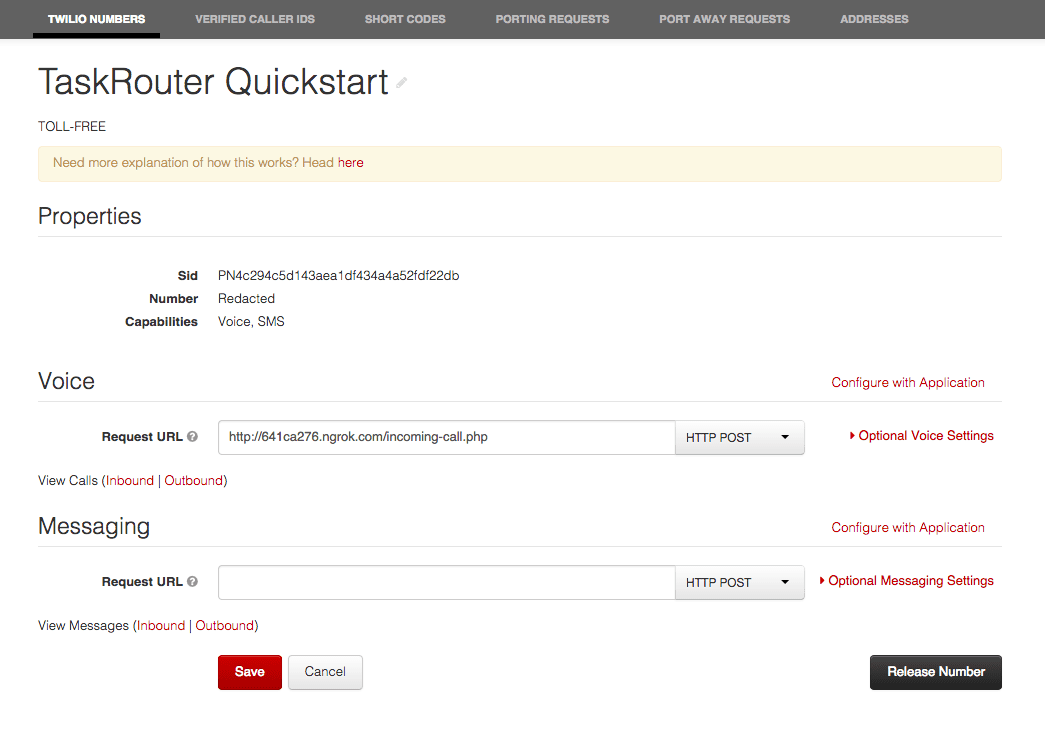Create Tasks from Phone Calls using TwiML: Receive an Incoming Call
We've seen how to create Tasks using the TaskRouter REST API and how to accept a Task Reservation using both the REST API and Assignment Callback instructions. TaskRouter also introduces new TwiML instructions that you can use to create a Task from a Twilio phone call.
To receive an incoming phone call, we first need a Twilio phone number. In this example we'll use a US toll-free number, but you can use a Voice capable number from any country.
Before purchasing or setting up the phone number, we need to add on to our run.py to handle incoming calls:
1# -*- coding: latin-1 -*-23from flask import Flask, request, Response4from twilio.rest import Client5from twilio.twiml.voice_response import VoiceResponse67app = Flask(__name__)89# Your Account Sid and Auth Token from twilio.com/user/account10account_sid = "{{ account_sid }}"11auth_token = "{{ auth_token }}"12workspace_sid = "{{ workspace_sid }}"13workflow_sid = "{{ workflow_sid }}"1415client = Client(account_sid, auth_token)1617@app.route("/assignment_callback", methods=['GET', 'POST'])18def assignment_callback():19"""Respond to assignment callbacks with an acceptance and 200 response"""2021ret = '{"instruction": "accept"}'22resp = Response(response=ret, status=200, mimetype='application/json')23return resp2425@app.route("/create_task", methods=['GET', 'POST'])26def create_task():27"""Creating a Task"""28task = client.workspaces(workspace_sid) \29.tasks.create(workflow_sid=workflow_sid,30attributes='{"selected_language":"es"}')3132print(task.attributes)33resp = Response({}, status=200, mimetype='application/json')34return resp3536@app.route("/accept_reservation", methods=['GET', 'POST'])37def accept_reservation(task_sid, reservation_sid):38"""Accepting a Reservation"""39task_sid = request.args.get('task_sid')40reservation_sid = request.args.get('reservation_sid')4142reservation = client.workspaces(workspace_sid) \43.tasks(task_sid) \44.reservations(reservation_sid) \45.update(reservation_status='accepted')4647print(reservation.reservation_status)48print(reservation.worker_name)4950resp = Response({}, status=200, mimetype='application/json')51return resp5253@app.route("/incoming_call", methods=['GET', 'POST'])54def incoming_call():55"""Respond to incoming requests."""5657resp = VoiceResponse()58with resp.gather(numDigits=1, action="/enqueue_call", method="POST", timeout=5) as g:59g.say("Para Español oprime el uno.", language='es')60g.say("For English, please hold or press two.", language='en')6162return str(resp)6364if __name__ == "__main__":65app.run(debug=True)
You can use the Buy Numbers section of the Twilio Voice and Messaging web portal to purchase a new phone number, or use an existing Twilio phone number. Open the phone number details page and point the Voice Request URL at your new endpoint:

Using any phone, call the Twilio number. You will be prompted to press one for Spanish or two for English. However, when you press a digit, you'll hear an error message. That's because our <Gather> verb is pointing to another endpoint, enqueue_call, which we haven't implemented yet. In the next step we'll add the required endpoint and use it to create a new Task based on the language selected by the caller.